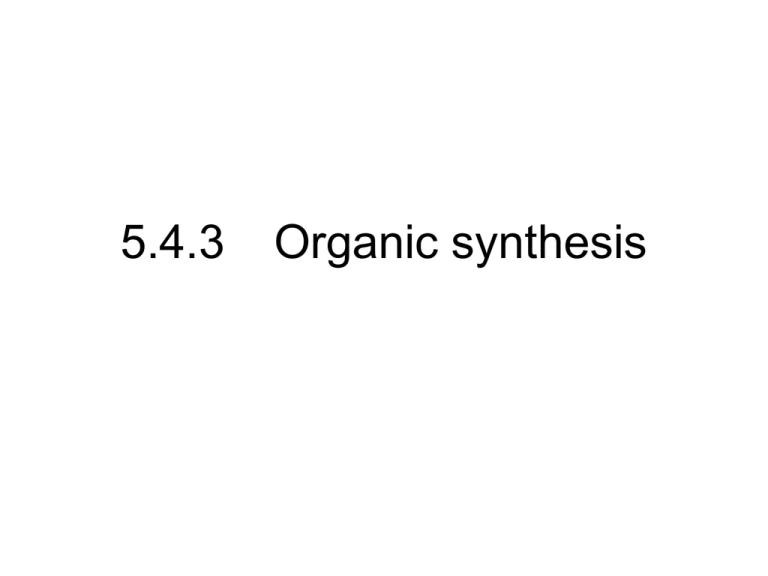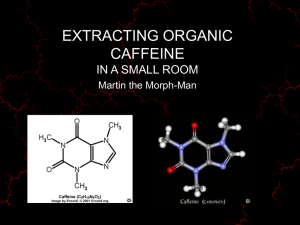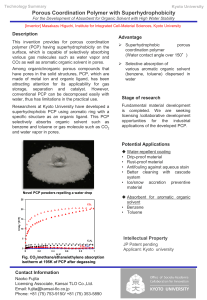Steam Distillation (contd)
advertisement

5.4.3
Organic synthesis
a.
give examples to illustrate the importance of organic synthesis in research for the production of useful products.
•
Organic synthesis involves the replication and modification of naturally occurring compounds, as well as the creation of new ones.
•
The dominant reason for conducting organic synthesis, is that it can be used to make a profit. This factor is rarely mentioned as this
motivation is very difficult to make us look like wonderful altruistic and principled beings engaged in a valiant worthy pursuit. The
marketing and advertising branches of society would would find it extremely difficult to employ their usual quiver of tools and tricks, in fact
it would probably have very few arrows to shoot in the direction of the consumer. So secondary (or lower) motivations are talked about
instead. Secondary motivations sound much better, they whitewash the unflattering primary motivation and consequently help make us
believe we are fantastic and such good people. Secondary motivation is something the marketing/advertising people love. They can
induce a warm and fuzzy feeling inside us. E.g. making new drugs to “help the sick” or “making some new useful component for device”
etc. If cancer or malaria rates are high, the chances are there’ll be a lot of work being done because the chance of great profit looms. If
cancer rates are low, or there is some rare disease which only a handful of people suffer from, expect little if any progress in organic
synthesis to be done to help those people. The fact that almost 1/7 people in the world go to sleep hungry each day and virtually nobody
helps them, is because they are poor and there’s no money to be made by helping them. It’s the same thing with synthesis. And because
profit is the main motivator, greed eventually makes its presence felt: More money can be made by treating symptoms rather than
providing a cure for them, or making a low quality component with a life-span to cover the warranty period only instead of making a quality
durable component. These things offer far greater potential for profit. The secondary factors are generally the ones the examiners would
expect you to write.
•
The primary factor for replicating naturally occurring organic compounds or modifying them or making new ones is that it will be cheaper,
hence more profitable.
•
Some useful naturally occurring compounds (e.g. the pain reliever salicilin found in the bark of the willow tree and in parts of the body of
otters) are present in small amounts and/or take a long time for natural processes to make them. Hence it is advantageous to make then
synthetically. Artificial compounds like cis-platin have also proven useful hence it is productive to replicate (manufacture) organic
compounds.
•
It is also useful to modify organic structures into new forms, the active ingredient in salicilin was said to cause stomach irritation. The
modified structure synthetically is supposedly reported to cause less irritation.
• b. explain why sensitive methods of chemical analysis are
important when planning and monitoring organic syntheses
‘Sensitive methods’ of detection and analysis ensure products can
be distinguished/identified from the reactants.
Sensitive techniques include NMR, HPLC, GC, IR, Look for
number of peaks, characteristic chemical shifts, splitting
patterns and integration heights, for HPLC, number of peaks,
retention factor of peaks (resolvable using solvents of different
polarity) and use of standards (usually keep some of the
reactants for this purpose). GC is similar but ensure compound
is sufficiently thermally stable, so as not to decompose. IR look
for peaks in the functional group region (<1500 cm-1). Bpt and
mpt also can be used as can chemical tests for ions like Ba2+
functional groups like C=O.
c.deduce the empirical formulae, molecular
formulae and structural formulae from data
drawn from combustion analysis, elemental
percentage composition, characteristic
reactions of functional groups, infrared
spectra, mass spectra and nuclear
magnetic resonance.
• The above have been covered in much
detail in my AS and A2 classes.
•
•
d.
use knowledge of organic chemistry contained in this specifications to solve
problems such as:
i.
predicting the properties of unfamiliar compounds containing one or more of
the functional groups included in the specification, and explain these predictions
•
Molecules containing OH’s behave like alcohols, compounds containing halogen
atoms behave like halogenalkanes. Compounds containing a mixture of functional
groups have properties of their individual groups. If functional groups are on the same
carbon then a new functional group forms, e.g. C=O bonded to OH, gives carboxylic
acid. C=O with NH2 (on the carbonyl carbon) gives amide etc.
•
ii.
planning reaction schemes of up to four steps, recalling familiar reactions and
using unfamiliar reactions given sufficient information
•
Create “spider diagrams” showing how all functional groups relate to each other by
conversion. Creating them is more helpful than just looking at them in the book.
Choose a simple molecule then choose another, try and use your reactions to change
them. May need one or two reactions off syllabus but will help reinforce the ones
actually on the syllabus as they are likely to be used
.
•
•
iii.
selecting suitable practical procedures for carrying out reactions involving
compounds with functional groups included in the specification
•
I.e. refluxing, distillation, steam distillation, solvent extraction, removing water using
anhydrous MgSO4 or Na2SO4 etc. vacuum filtration, gravity filtration…
•
iv.
identifying appropriate control measures to reduce risk during a synthesis
based upon data of hazards
•
Choose less reactive species, use lower quantities, minimize solvent use and recycle
solvent use (or replace them altogether with these new ‘ionic liquids’)
•
v.
understanding why, in the synthesis of stereo-specific drugs, it is important to
understand the mechanism of the reaction and how this can help to plan the
synthesis
•
Stereoisomers (geometric [cis-platin] and optical [thalidomide] ) can have radically
different biological effects, some disastrous. Should choose mechanisms that do NOT
give racemic mixtures in cases where one enantiomer is biologically damaging. E.g.
SN2 mechanisms will not give racemic mixtures. In certain circumstances, SN1
reactions and Addition reactions may also produce racemic mixtures,
e.explain why the pharmaceutical industry
has adopted combinatorial chemistry in
drug research, including passing reactants
over reagents on polymer supports
Combinational Chemistry
• Collection of techniques which allow for the synthesis of multiple
compounds at the same time rapid synthesis (compared to
traditional synthesis methods). Specific sequences of molecular
constituents/parts can created e.g. proteins, specific multi monomer
polymers. E.g. one end of some kind of monomer is attached to a
bead. Different monomers are attached to a different bead (e.g each
bead has an alcohol with a different chain length bonded to it). All
beads are then mixed together with a compound that will react with
the functional group present in the monomers (e.g. a difunctional
carboxylic acid). The beads are then removed by filtration and
washed. The molecule sticks to the bead. All beads can then be
separated and each bead put into a specific difunctional alcohol,
creating a second ester linkage. Beads are removed again, washed
and then ALL put into the same difunctional carboxylic again. This
process is repeated again and again and a so a number of specific
polyesters can be created at the same time with great efficiency.
This way sequence of monomers can be precisely controlled as can
the chain length. This can be done for any polymer, such as
polyamides, polyesters, polypeptides (proteins) etc. See the diagram
after the next text slide.
(combinational chem contd.)
• Waste/excess reagent can be washed away and beads
retained. Beads may have many reaction sites on them.
• When finished and separated, molecule is cleaved from
the bead to yield the final product.
• Purification/isolation steps is largely made redundant..
• Leads to much greater efficiency in : organic synthesis,
drug discovery, aiding catalyst design, and material
sciences.
Many beads of
one type
(to mix) and divide into batches
(to mix) and divide into batches
• http://chem35132007.pbworks.com/w/page/15648417/Combinatorial%20Chemistry
• http://chem35132007.pbworks.com/w/page/15648417/Combinatorial%20Chemistry
These columns of test tubes are
prepared first.
Resulting matrix of products
This row sequence of alcohols is
then added to the test tubes
Refluxing
• Allows of for
higher temps to
be used, without
loss of solvent or
reactant, hence
reaction rate
increases.
• SHOW OPEN
SYSTEM and NO
BUNSEN
Distillation
• When
thermometer
reading
const, a
single
substance is
coming off.
Open at end
only!
Open at end only!
(& not near
thermometer / entrance to
condenser)
• If bpt = 81oC, collect fraction from +/- 1oC of the bpt
Steam Distillation
• Steam distillation: Use when normal distillation
could cause compound to decompose. Allows
distillation (compound and water vapor droplets)
to “distill” off at a lower temperature.
• Need to remove water at end (e.g. use
separating funnel and do liquid-liquid extraction
{sometimes solvent extraction} on water layer)
After, DRY product (e.g. anhydrous MgSO4)
Steam Distillation (contd)
• Used for natural oils / hydrophobic
molecules / complex esters etc. Example
is limonene from orange peel.
Steam distillation 1
(simple set-up)
• Open system at end only.
http://thegeekgroup.org/forums/topic/steam-distillation-of-catnip-to-producenepetalactone/
Steam distillation 2 (slightly more
complicated set-up)
• Steam distillation VIDEO – Limonene
• http://www.youtube.com/watch?v=1OfLPQ
-29Iw
Recrystalization (of solids)
• If product (solid) mixed with liquid (e.g. 2,4-DNP
derivative) use vacuum filtration.
• Dissolve in minimum amount of hot solvent.,
i.e. while under heat, add hot solvent until solid
just dissolves. Good solvent = dissolves solid when hot but not
when cold.
Do gravity filtration when hot using fluted filter
paper and a preheated stemless funnel.
• Allow to cool SLOWLY. Once cooled cool in ice
• Do vacuum filtration. Wash solid with a few
drops of ice-cold solvent.
• Allow solid to dry in a desiccator.
The liquid produced after filtering a solid in a liquid is called filtrate.
• Note: “Suitable solvent” has poor solubility
for the solute(substance to be dissolved)
when cold, and high solubility for solute
when hot.
• Video of Recrystalisation =
• Organic Chemistry Lab: Recrystallization
http://www.youtube.com/watch?v=XK0MZk3Q4jk
Solvent (liquid-liquid) extraction
• A compound has an appreciable difference in solubility between two
immiscible (i.e. cannot mix – get two separate liquid layers) solvents (one often being
water, the other usually organic solvent e.g. diethylether).
• Organic compound usually more soluble in non-water solvent.
• Use Separating funnel (straight or round)
• Add roughly equal amount of solvent and (usually water based)
mixture into sep funnel.
• Stopper and shake, opening tap when inverted (hold stopper in
place) to allow gas pressure build up to escape. Drain off water
layer. Keep organic layer.
• Wash the water layer with more organic solvent.
• Can add salt to make water later more polar forcing the compound
out of the water even more.
• Combine all organic layers. Add anhydrous MgSO4 to remove
traces of water. Filter and evaporate organic solvent leaving product
behind.
Solvent extrction
This technique is also useful at
removing ionic and polar
impurities from a reaction
product if water and non-polar
solvents are used. The polar
and ionic impurities will enter
the aqueous layer.
http://www.tutorbene.com/index.aspx?PageID=92
• YouTube video on liquid-liquid extraction: Liquid-liquid
extraction (or separation)
http://www.youtube.com/watch?v=vcwfhDhLiQU
and
Organic Chemistry Lab Demo: Extractions (part 1)
http://www.youtube.com/watch?v=CyIA8NhMUl4&feature=r
elated
Organic Chemistry Lab Demo: Extraction
techniques sourcs of confustion (emulsions) (i.e.
part 2)
http://www.youtube.com/watch?v=CyIA8NhMUl4








